3102AFE Auditing: Risk Assessment and Audit Strategy Analysis
VerifiedAdded on 2022/11/10
|8
|1775
|447
Report
AI Summary
This report provides a comprehensive risk assessment and audit strategy for Mung Ltd., a furniture manufacturing company. It begins by identifying and analyzing inherent risks, such as slowing inventory turnover and potential manipulation of accounting figures, and assesses their degree. The report then examines control risks related to management assertions, specifically focusing on the occurrence of sales revenue, and identifies existing internal controls. Analytical procedures for assessing misstatements are discussed, including the use of an audit risk model and audit planning decisions. The report also provides an overview of the company's financial ratios, including interest coverage and debt/assets ratios. Based on the risk assessment, a risk-based audit approach is recommended. The report further outlines relevant audit tests, including reperformance and inspection, and substantive procedures like confirmation of sales revenue balances. Finally, the report concludes by emphasizing the importance of these strategies in ensuring the accuracy of financial records and mitigating potential risks within the company. The report also highlights the significance of segregation of duties, and the importance of the audit team to be able to analyze and validate the transactions. The report concludes by emphasizing the significance of these strategies in ensuring the accuracy of financial records and mitigating potential risks within the company.
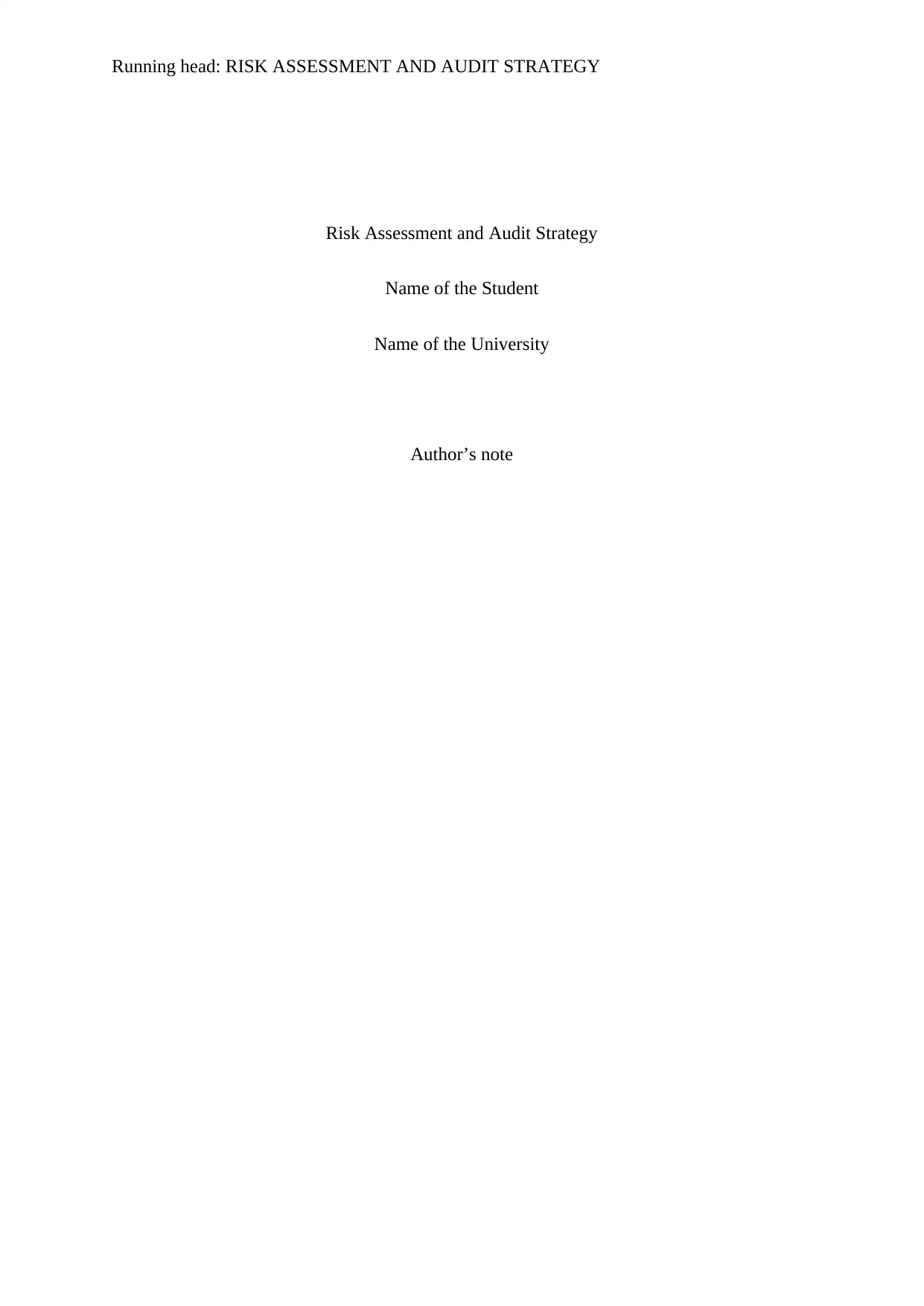
Running head: RISK ASSESSMENT AND AUDIT STRATEGY
Risk Assessment and Audit Strategy
Name of the Student
Name of the University
Author’s note
Risk Assessment and Audit Strategy
Name of the Student
Name of the University
Author’s note
Paraphrase This Document
Need a fresh take? Get an instant paraphrase of this document with our AI Paraphraser
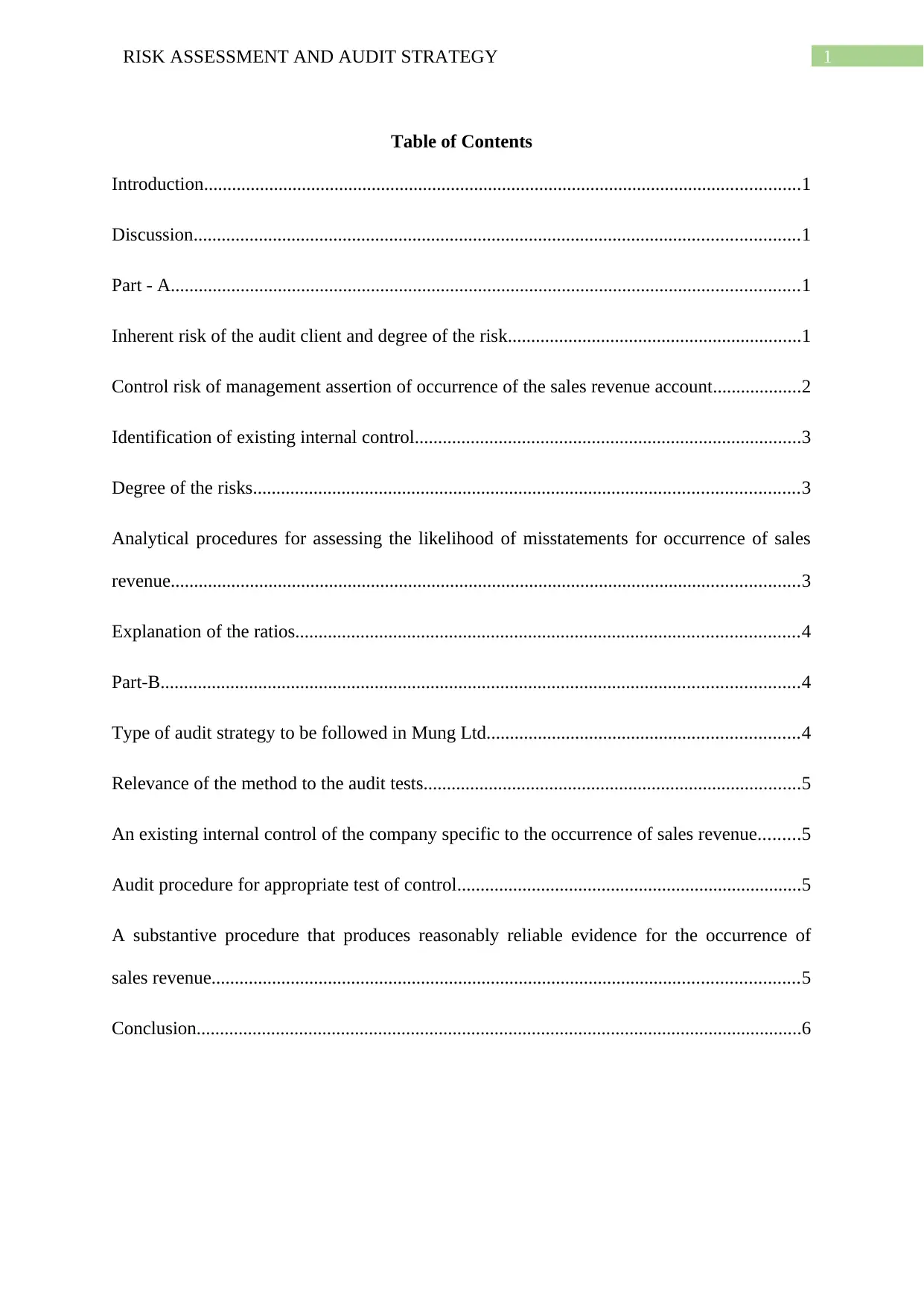
1RISK ASSESSMENT AND AUDIT STRATEGY
Table of Contents
Introduction................................................................................................................................1
Discussion..................................................................................................................................1
Part - A.......................................................................................................................................1
Inherent risk of the audit client and degree of the risk...............................................................1
Control risk of management assertion of occurrence of the sales revenue account...................2
Identification of existing internal control...................................................................................3
Degree of the risks.....................................................................................................................3
Analytical procedures for assessing the likelihood of misstatements for occurrence of sales
revenue.......................................................................................................................................3
Explanation of the ratios............................................................................................................4
Part-B.........................................................................................................................................4
Type of audit strategy to be followed in Mung Ltd...................................................................4
Relevance of the method to the audit tests.................................................................................5
An existing internal control of the company specific to the occurrence of sales revenue.........5
Audit procedure for appropriate test of control..........................................................................5
A substantive procedure that produces reasonably reliable evidence for the occurrence of
sales revenue..............................................................................................................................5
Conclusion..................................................................................................................................6
Table of Contents
Introduction................................................................................................................................1
Discussion..................................................................................................................................1
Part - A.......................................................................................................................................1
Inherent risk of the audit client and degree of the risk...............................................................1
Control risk of management assertion of occurrence of the sales revenue account...................2
Identification of existing internal control...................................................................................3
Degree of the risks.....................................................................................................................3
Analytical procedures for assessing the likelihood of misstatements for occurrence of sales
revenue.......................................................................................................................................3
Explanation of the ratios............................................................................................................4
Part-B.........................................................................................................................................4
Type of audit strategy to be followed in Mung Ltd...................................................................4
Relevance of the method to the audit tests.................................................................................5
An existing internal control of the company specific to the occurrence of sales revenue.........5
Audit procedure for appropriate test of control..........................................................................5
A substantive procedure that produces reasonably reliable evidence for the occurrence of
sales revenue..............................................................................................................................5
Conclusion..................................................................................................................................6
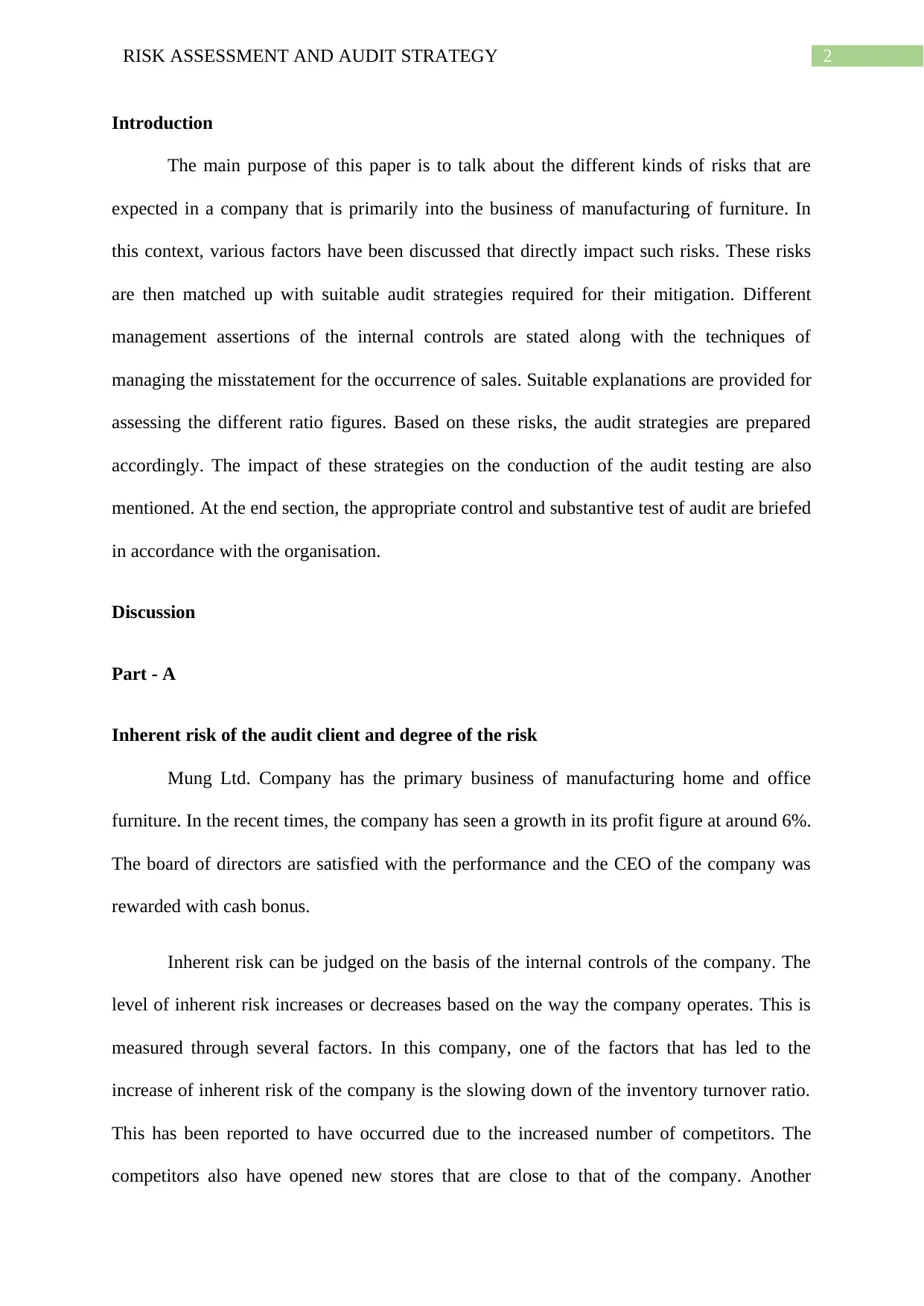
2RISK ASSESSMENT AND AUDIT STRATEGY
Introduction
The main purpose of this paper is to talk about the different kinds of risks that are
expected in a company that is primarily into the business of manufacturing of furniture. In
this context, various factors have been discussed that directly impact such risks. These risks
are then matched up with suitable audit strategies required for their mitigation. Different
management assertions of the internal controls are stated along with the techniques of
managing the misstatement for the occurrence of sales. Suitable explanations are provided for
assessing the different ratio figures. Based on these risks, the audit strategies are prepared
accordingly. The impact of these strategies on the conduction of the audit testing are also
mentioned. At the end section, the appropriate control and substantive test of audit are briefed
in accordance with the organisation.
Discussion
Part - A
Inherent risk of the audit client and degree of the risk
Mung Ltd. Company has the primary business of manufacturing home and office
furniture. In the recent times, the company has seen a growth in its profit figure at around 6%.
The board of directors are satisfied with the performance and the CEO of the company was
rewarded with cash bonus.
Inherent risk can be judged on the basis of the internal controls of the company. The
level of inherent risk increases or decreases based on the way the company operates. This is
measured through several factors. In this company, one of the factors that has led to the
increase of inherent risk of the company is the slowing down of the inventory turnover ratio.
This has been reported to have occurred due to the increased number of competitors. The
competitors also have opened new stores that are close to that of the company. Another
Introduction
The main purpose of this paper is to talk about the different kinds of risks that are
expected in a company that is primarily into the business of manufacturing of furniture. In
this context, various factors have been discussed that directly impact such risks. These risks
are then matched up with suitable audit strategies required for their mitigation. Different
management assertions of the internal controls are stated along with the techniques of
managing the misstatement for the occurrence of sales. Suitable explanations are provided for
assessing the different ratio figures. Based on these risks, the audit strategies are prepared
accordingly. The impact of these strategies on the conduction of the audit testing are also
mentioned. At the end section, the appropriate control and substantive test of audit are briefed
in accordance with the organisation.
Discussion
Part - A
Inherent risk of the audit client and degree of the risk
Mung Ltd. Company has the primary business of manufacturing home and office
furniture. In the recent times, the company has seen a growth in its profit figure at around 6%.
The board of directors are satisfied with the performance and the CEO of the company was
rewarded with cash bonus.
Inherent risk can be judged on the basis of the internal controls of the company. The
level of inherent risk increases or decreases based on the way the company operates. This is
measured through several factors. In this company, one of the factors that has led to the
increase of inherent risk of the company is the slowing down of the inventory turnover ratio.
This has been reported to have occurred due to the increased number of competitors. The
competitors also have opened new stores that are close to that of the company. Another
⊘ This is a preview!⊘
Do you want full access?
Subscribe today to unlock all pages.

Trusted by 1+ million students worldwide

3RISK ASSESSMENT AND AUDIT STRATEGY
reason for this is the reduction in the popularity of furniture among the customers in the
recent days.
Another risk which can be considered to be inherent within the business of the client
can be the accounting department. The accounting department operates separately from all
other departments. The CEO cannot access the accounting records directly. Therefore, he has
to rely on the information provided by the accountants for keeping the record of the accounts
figures. There can be a chance of manipulation of the accounting figures by the accountant.
Similarly, this risk is also inherent in other department such as sales and inventory
management. This is because all these departments are only accessible to the authorised staff
via individual passwords. Such staff can always manipulate accounting figures.
However, despite of all these risks, the company reports that the CEO holds a very
good relationship with the chief accountant who takes care of the entire accounting
department very efficiently. The accountant also reports to the CEO on a regular basis,
discussing on the issues and changes that would be crucial in the accounting department. Due
to this reason, the level of inherent risk can be compensated up to a certain extent.
Considering the case of Mung Ltd. company, the level of inherent risk can be
considered to be medium. This is because the increased level of inherent risk in the three key
departments is mitigated up to a certain level by the company through good relationships with
the chief authorised staff of these departments.
Control risk of management assertion of occurrence of the sales revenue account
The different assertions that are provided by the management with respect to the sales
revenue account are completeness, understandability, and accuracy of their internal control
system. The management has claimed that their system of sales operation has performed well
reason for this is the reduction in the popularity of furniture among the customers in the
recent days.
Another risk which can be considered to be inherent within the business of the client
can be the accounting department. The accounting department operates separately from all
other departments. The CEO cannot access the accounting records directly. Therefore, he has
to rely on the information provided by the accountants for keeping the record of the accounts
figures. There can be a chance of manipulation of the accounting figures by the accountant.
Similarly, this risk is also inherent in other department such as sales and inventory
management. This is because all these departments are only accessible to the authorised staff
via individual passwords. Such staff can always manipulate accounting figures.
However, despite of all these risks, the company reports that the CEO holds a very
good relationship with the chief accountant who takes care of the entire accounting
department very efficiently. The accountant also reports to the CEO on a regular basis,
discussing on the issues and changes that would be crucial in the accounting department. Due
to this reason, the level of inherent risk can be compensated up to a certain extent.
Considering the case of Mung Ltd. company, the level of inherent risk can be
considered to be medium. This is because the increased level of inherent risk in the three key
departments is mitigated up to a certain level by the company through good relationships with
the chief authorised staff of these departments.
Control risk of management assertion of occurrence of the sales revenue account
The different assertions that are provided by the management with respect to the sales
revenue account are completeness, understandability, and accuracy of their internal control
system. The management has claimed that their system of sales operation has performed well
Paraphrase This Document
Need a fresh take? Get an instant paraphrase of this document with our AI Paraphraser

4RISK ASSESSMENT AND AUDIT STRATEGY
and has catered to the organisational objective. This might have different control risks due to
unauthenticity of these assertion claims.
Considering the completeness assertion, the management has claimed that the
business events that have led to the occurrence of the sale revenue account are complete. For
the assertion relating to understandability, the management has claimed that the information
for the internal system as recorded in the financial statements has been appropriately
presented and is also clearly understandable. For the assertion of accuracy, the management
stated that the information describing the internal control system of the organisation has been
accurately presented in the financial statements. The information disclosed about the system
is produced in correct amount.
Identification of existing internal control
The management of the system explained that the chief accountant responsible for
accounting the revenue of the organisation is hired by CEO and they are good friends.
Therefore, the CEO does not need to intervene in the accounting department as the
accountant keeps him updated with all the information. Through this way, the organisation
has been able to prevent the misstatements that might occur in the sales revenue account.
Degree of the risks
The assessment suggests risks which are not very high. This is because the good
relationship of the CEO with the accountant might be serve as an important factor in carrying
out the internal controls effectively.
Analytical procedures for assessing the likelihood of misstatements for occurrence of
sales revenue
The different analytical procedures that could be applied for assessing the likelihood
of the misstatements in the sales revenue account could be usage of an audit risk model.
and has catered to the organisational objective. This might have different control risks due to
unauthenticity of these assertion claims.
Considering the completeness assertion, the management has claimed that the
business events that have led to the occurrence of the sale revenue account are complete. For
the assertion relating to understandability, the management has claimed that the information
for the internal system as recorded in the financial statements has been appropriately
presented and is also clearly understandable. For the assertion of accuracy, the management
stated that the information describing the internal control system of the organisation has been
accurately presented in the financial statements. The information disclosed about the system
is produced in correct amount.
Identification of existing internal control
The management of the system explained that the chief accountant responsible for
accounting the revenue of the organisation is hired by CEO and they are good friends.
Therefore, the CEO does not need to intervene in the accounting department as the
accountant keeps him updated with all the information. Through this way, the organisation
has been able to prevent the misstatements that might occur in the sales revenue account.
Degree of the risks
The assessment suggests risks which are not very high. This is because the good
relationship of the CEO with the accountant might be serve as an important factor in carrying
out the internal controls effectively.
Analytical procedures for assessing the likelihood of misstatements for occurrence of
sales revenue
The different analytical procedures that could be applied for assessing the likelihood
of the misstatements in the sales revenue account could be usage of an audit risk model.
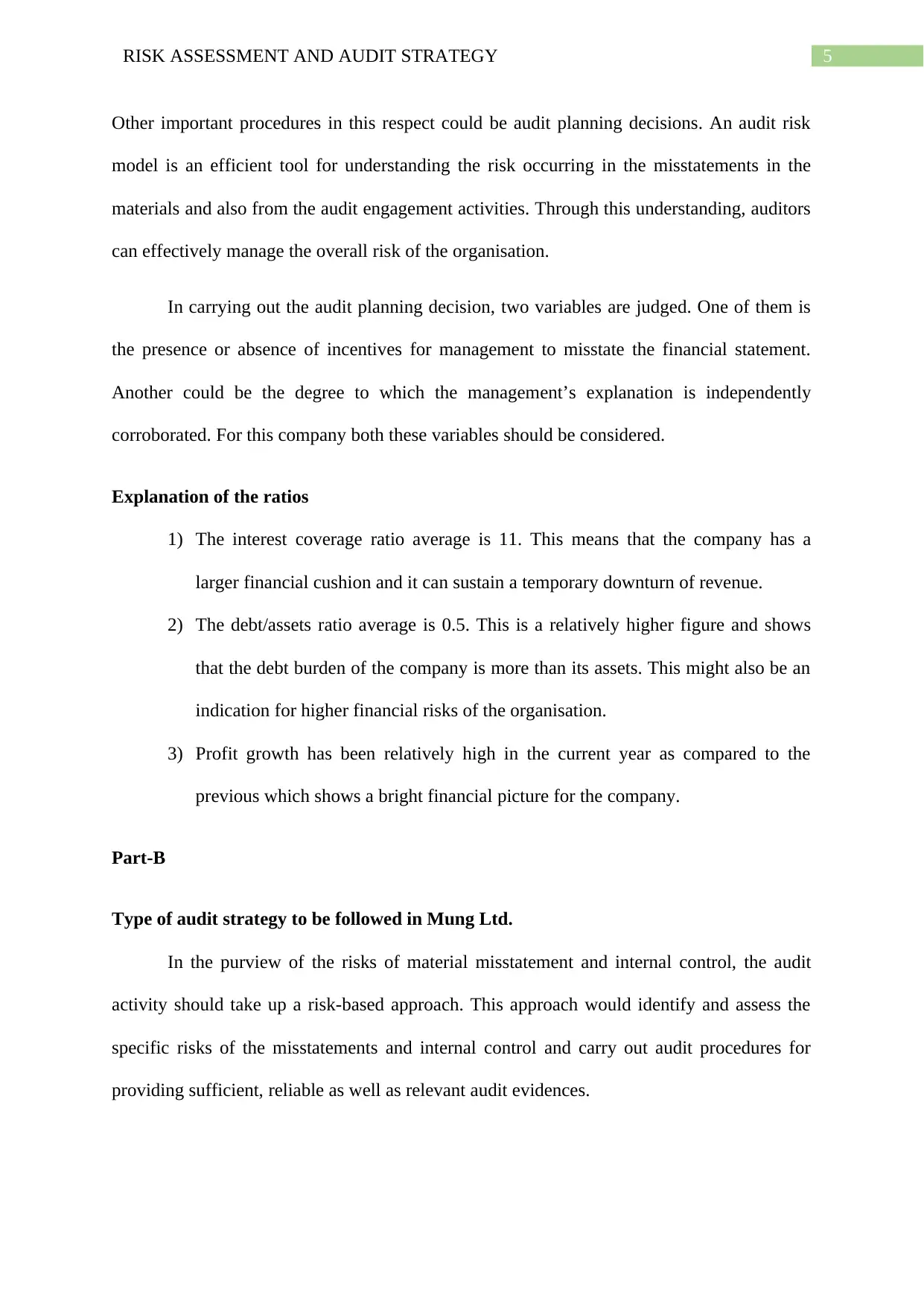
5RISK ASSESSMENT AND AUDIT STRATEGY
Other important procedures in this respect could be audit planning decisions. An audit risk
model is an efficient tool for understanding the risk occurring in the misstatements in the
materials and also from the audit engagement activities. Through this understanding, auditors
can effectively manage the overall risk of the organisation.
In carrying out the audit planning decision, two variables are judged. One of them is
the presence or absence of incentives for management to misstate the financial statement.
Another could be the degree to which the management’s explanation is independently
corroborated. For this company both these variables should be considered.
Explanation of the ratios
1) The interest coverage ratio average is 11. This means that the company has a
larger financial cushion and it can sustain a temporary downturn of revenue.
2) The debt/assets ratio average is 0.5. This is a relatively higher figure and shows
that the debt burden of the company is more than its assets. This might also be an
indication for higher financial risks of the organisation.
3) Profit growth has been relatively high in the current year as compared to the
previous which shows a bright financial picture for the company.
Part-B
Type of audit strategy to be followed in Mung Ltd.
In the purview of the risks of material misstatement and internal control, the audit
activity should take up a risk-based approach. This approach would identify and assess the
specific risks of the misstatements and internal control and carry out audit procedures for
providing sufficient, reliable as well as relevant audit evidences.
Other important procedures in this respect could be audit planning decisions. An audit risk
model is an efficient tool for understanding the risk occurring in the misstatements in the
materials and also from the audit engagement activities. Through this understanding, auditors
can effectively manage the overall risk of the organisation.
In carrying out the audit planning decision, two variables are judged. One of them is
the presence or absence of incentives for management to misstate the financial statement.
Another could be the degree to which the management’s explanation is independently
corroborated. For this company both these variables should be considered.
Explanation of the ratios
1) The interest coverage ratio average is 11. This means that the company has a
larger financial cushion and it can sustain a temporary downturn of revenue.
2) The debt/assets ratio average is 0.5. This is a relatively higher figure and shows
that the debt burden of the company is more than its assets. This might also be an
indication for higher financial risks of the organisation.
3) Profit growth has been relatively high in the current year as compared to the
previous which shows a bright financial picture for the company.
Part-B
Type of audit strategy to be followed in Mung Ltd.
In the purview of the risks of material misstatement and internal control, the audit
activity should take up a risk-based approach. This approach would identify and assess the
specific risks of the misstatements and internal control and carry out audit procedures for
providing sufficient, reliable as well as relevant audit evidences.
⊘ This is a preview!⊘
Do you want full access?
Subscribe today to unlock all pages.

Trusted by 1+ million students worldwide

6RISK ASSESSMENT AND AUDIT STRATEGY
Relevance of the method to the audit tests
This method would be relevant for the audit tests because the method would increase
the ease of finding evidences in the process of audit tests. This would consequently increase
the accuracy and validity of the financial records of the company.
An existing internal control of the company specific to the occurrence of sales revenue
An internal control that has been designed by the company is the segregation of the
three key departments, that is accounting, sales and inventory departments. The departments
are controlled through their respective heads. The CEO does not interfere directly in the
process but only takes updates through these departmental heads.
Audit procedure for appropriate test of control
The auditors may take up two kinds of strategies for testing the internal controls of the
organisation. One of them could be reperformance, that is, initiation of a new transaction with
the organisation for looking into the effectiveness of the controls. Another one could be
inspection for examining the different business documents in order to find out approved
signatures or stamps.
A substantive procedure that produces reasonably reliable evidence for the occurrence
of sales revenue
A significant substantive audit procedure for checking the reliability of the financial
materials could be confirmation of the sales revenue account balances with the third parties
such as lenders or suppliers. The audit team must also recalculate the calculations that are
shown in the financial statements of the client. Finally, the transactions should be observed
carefully by the audit team for analysing their validity.
Relevance of the method to the audit tests
This method would be relevant for the audit tests because the method would increase
the ease of finding evidences in the process of audit tests. This would consequently increase
the accuracy and validity of the financial records of the company.
An existing internal control of the company specific to the occurrence of sales revenue
An internal control that has been designed by the company is the segregation of the
three key departments, that is accounting, sales and inventory departments. The departments
are controlled through their respective heads. The CEO does not interfere directly in the
process but only takes updates through these departmental heads.
Audit procedure for appropriate test of control
The auditors may take up two kinds of strategies for testing the internal controls of the
organisation. One of them could be reperformance, that is, initiation of a new transaction with
the organisation for looking into the effectiveness of the controls. Another one could be
inspection for examining the different business documents in order to find out approved
signatures or stamps.
A substantive procedure that produces reasonably reliable evidence for the occurrence
of sales revenue
A significant substantive audit procedure for checking the reliability of the financial
materials could be confirmation of the sales revenue account balances with the third parties
such as lenders or suppliers. The audit team must also recalculate the calculations that are
shown in the financial statements of the client. Finally, the transactions should be observed
carefully by the audit team for analysing their validity.
Paraphrase This Document
Need a fresh take? Get an instant paraphrase of this document with our AI Paraphraser
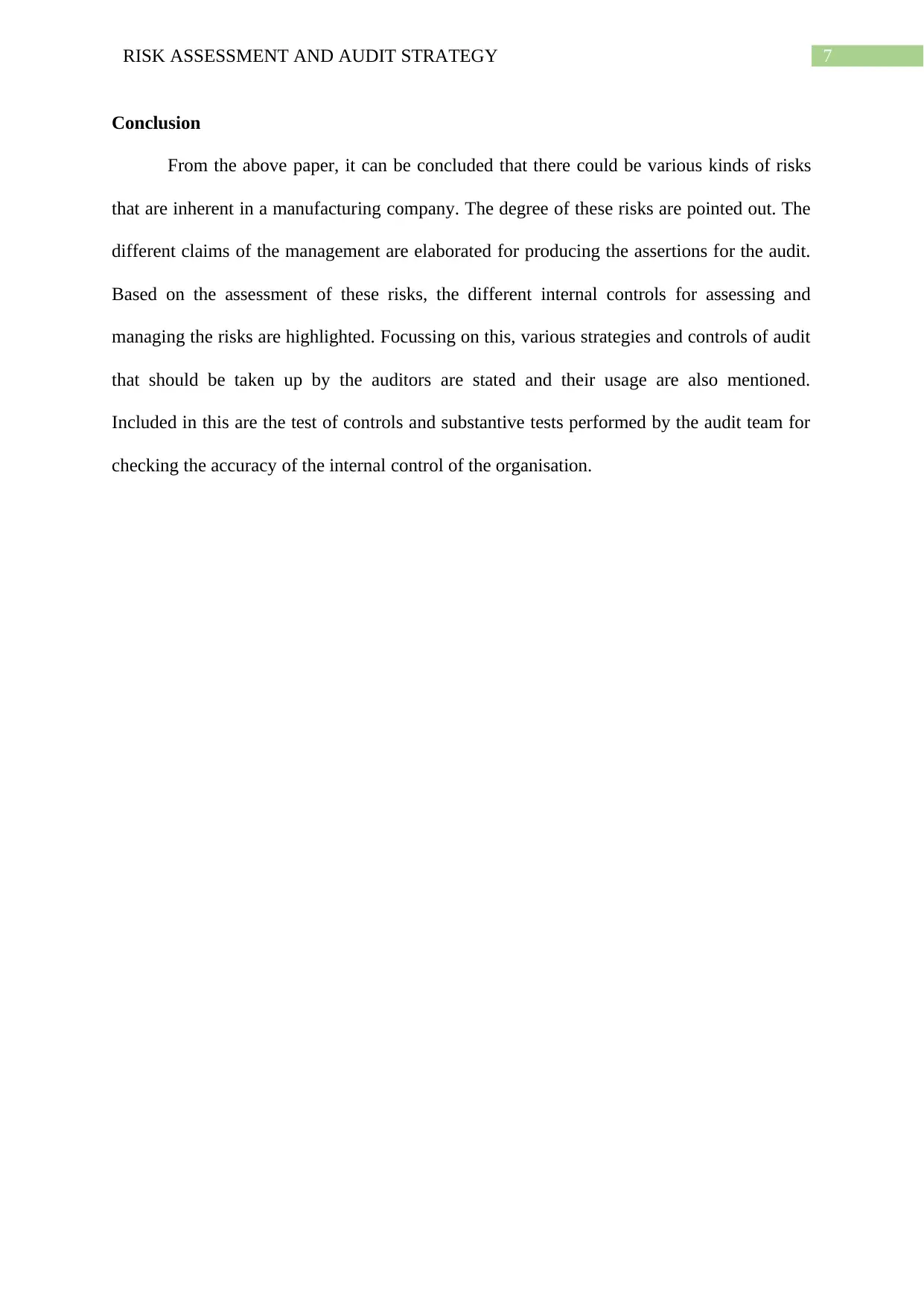
7RISK ASSESSMENT AND AUDIT STRATEGY
Conclusion
From the above paper, it can be concluded that there could be various kinds of risks
that are inherent in a manufacturing company. The degree of these risks are pointed out. The
different claims of the management are elaborated for producing the assertions for the audit.
Based on the assessment of these risks, the different internal controls for assessing and
managing the risks are highlighted. Focussing on this, various strategies and controls of audit
that should be taken up by the auditors are stated and their usage are also mentioned.
Included in this are the test of controls and substantive tests performed by the audit team for
checking the accuracy of the internal control of the organisation.
Conclusion
From the above paper, it can be concluded that there could be various kinds of risks
that are inherent in a manufacturing company. The degree of these risks are pointed out. The
different claims of the management are elaborated for producing the assertions for the audit.
Based on the assessment of these risks, the different internal controls for assessing and
managing the risks are highlighted. Focussing on this, various strategies and controls of audit
that should be taken up by the auditors are stated and their usage are also mentioned.
Included in this are the test of controls and substantive tests performed by the audit team for
checking the accuracy of the internal control of the organisation.
1 out of 8
Related Documents
Your All-in-One AI-Powered Toolkit for Academic Success.
+13062052269
info@desklib.com
Available 24*7 on WhatsApp / Email
![[object Object]](/_next/static/media/star-bottom.7253800d.svg)
Unlock your academic potential
Copyright © 2020–2025 A2Z Services. All Rights Reserved. Developed and managed by ZUCOL.





